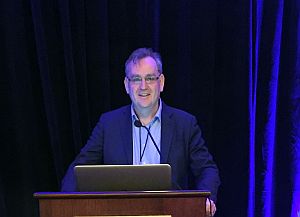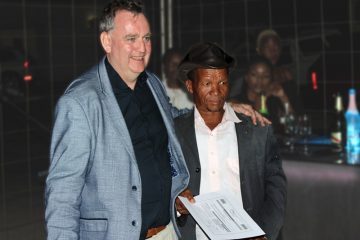Africa New Energies celebrates Namibia government’s 100% concession renewal

Southern Africa-focused oil and gas explorer Africa New Energies (ANE) hailed the decision by Namibia’s Ministry of Mines and Energy in June to renew 100% of its 22,000 square kilometre concession for another two years as “an expression of confidence” in its strategy to tap the country’s hydrocarbon potential and boost power generation in the Southern African nation.
Alumni Exploration East Namibia (Pty) Ltd, a wholly-owned subsidiary of ANE, was notified in writing on June 11th by Ministry of Mines Petroleum Commissioner Maggy Shino of its decision to renew the concession – made up of blocks 2219 and 2319 in the east of the country – in its entirety, waiving its option of taking back 50% of the concession as is its right under the provisions of the 1991 Petroleum Act.
ANE retains its entire concession
The decision means that ANE’s right to explore and develop its entire concession have been extended for an additional two years until June 2020, giving the company more time to conduct satellite remote sensing surveys, airborne geophysical surveys on revolutionary new low-level gyrocopter aircraft, and the first exploratory drilling on its concession the size of Wales.
Immanuel Ambata, ANE’s in-house field geologist – who played a pivotal role in ensuring that ANE complied with all the provisions of its exploration licence – said that it was extremely rare for the Ministry to do this. “You have to demonstrate that you have a comprehensive exploration programme, and you have to be able to execute it,” Ambata said. “Some companies fail to do this, so the Ministry can refuse to renew their concession,” he added.
Ambata said that ANE had adhered rigorously to the commitments made by company executives in the licence agreement, including: “carrying out a satellite imaging programme, and conducting an extensive geochemical survey in which more than 1,500 soil samples on the concession were collected and them subject to analysis in the laboratory.”
A new exploration strategy
He insisted, however, that the next stage of the company’s exploration programme was even more ambitious. But instead of proceeding with traditional and prohibitively expensive seismic surveys, ANE is preparing to launch a novel approach to oil and gas exploration. “We are not going to use seismic,” Ambata said. “Instead, we have come up with a new strategy.”
“We are now about to do the gravity survey,” Ambata added. This will entail flying a gyrocopter over the concession at 20 meters above the canopy, and collect gravity data readings. Gravity is higher where there is greater density of rock, and lower where the density is less, which is a potential indicator of hydrocarbons. “We are using low-cost, non-traditional exploration techniques, which we hope to do by the final quarter of 2018,” Ambata said.
Once the gyrocopter gravity surveys have been completed, ANE plans to proceed with the collection of more satellite imaging before embarking on the drilling of the first two wells of a planned ten-well drilling programme, Ambata said. The drilling is expected to take place in areas which have high concentrations of hydrocarbon seeps, he added.
Intriguingly, ANE is not the only party exploring its own concession. Evidence has emerged in recent months of illegal drilling, which the company has reported to the Ministry. But in a separate incident, evidence has also emerged that the Chinese have been carrying out illegal drilling, which has also been reported to the Ministry.
Ministry’s decision ‘an expression of confidence’
Brendon Raw, a co-founder of ANE, said that the Ministry’s decision to renew the concession in full was “an expression of confidence” in ANE exploration and development programme. “We have invested a lot of time and effort in the concession area, and we believe that it is highly prospective. We wanted to keep all of the area to protect our investment,” he added.
“Obviously, there was a fear that we would have to hand back some of the concession,” Raw said. “Other parties had expressed an interest in our blocks. So it was something of a relief that the Ministry likes what we have been doing so far, and did not want to harm our interests – or theirs – by forcing us to give up some of the concession. The Ministry’s decision gives us a lot more time – it’s like putting the clock back – it gives us an extra two years to explore.”
Further boost from German grant
ANE received a further boost in June when its collaborative partner Gravionic GmbH www.gravionic.com – specialists in the development of complex sensor systems – was awarded a €376,000 grant from the German government to mount its gravity and magnetic surveying equipment to a gyrocopter for the very first time. Gravionic’s first customer will be Gyrotek, a South African-based start-up, which will be responsible for conducting passive seismic surveys on ANE’s Namibia concession.
Gravionic is a spin-off from the Institute of Flight Guidance and Control (IFF) of the Technical University of Braunschweig, and is a market leader in using gravity and magnetic data – known as a gravitometer – to enhance traditional seismic surveys with additional information for the interpretation of complex geological structures.
Not only are traditional airborne seismic surveys prohibitively expensive, the data they collect is flawed, and they have difficultly mapping pre-salt structures – the geological formations on continental shelve basins that were formed after the break-up of the super continent Gondwana more than 300 million years ago – which often host large deposits of hydrocarbons.
Traditional seismic surveys are carried out using fixed-wing aircraft, which fly too high to be able to pick up the subtle signals that indicate the presence of commercially extractable hydrocarbon resources. Gyrocopters by contrast, can fly slowly at twenty meters above the canopy, enabling them to collect more data, more accurately.
Gravity and magnetic surveying are passive measurements since they do not send any signals into the ground to create a disturbance which can be measured. Due to the passive characteristics of the signals, this kind of surveying is also much more eco-friendly, and more effective.



0 Comments